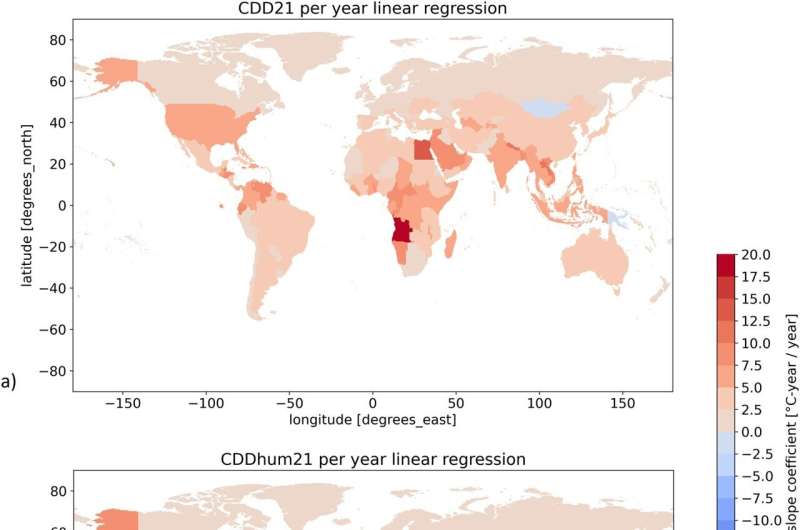This article has been reviewed according to Science X's editorial process and policies. Editors have highlighted the following attributes while ensuring the content's credibility:
fact-checked
peer-reviewed publication
proofread
An energy-demanding loop: Study estimates how warming climate drives demand for cooling at country-level worldwide

A higher energy demand has been registered over the past decades in different sectors, including buildings, industry, and transportation, resulting in a notable rise in global energy consumption. In this context, population growth and global warming present an additional obstacle to meeting future energy needs and fulfilling energy demands worldwide.
Over the last twenty years, cooling has been the fastest increasing energy use in urban areas, as a consequence of a clear increase in ownership of cooling equipment, mainly in more developed countries.
On the other hand, the majority of the world's largest urban centers are located in emerging countries, including India, Southeast Asia, and Africa, which are usually areas experiencing warm to hot weather conditions. Additionally, many tropical countries have relatively low rates of households equipped with air conditioning, indicating an untapped potential for a surge in future energy consumption.
For these reasons, it is important to characterize and estimate the global trend in cooling demand, to understand, analyze and model the energy sector, from energy generation to its consumption.
A paper recently published in Communications Earth & Environment by researchers of the CMCC Foundation and the International Energy Agency (IEA) gives a first attempt at estimating how a warming climate can drive energy demand for cooling at country-level worldwide.
Cooling degree days represent an indicator of how much and for how long the outdoor air temperature is above a certain threshold, and is therefore used as an effective metric to estimate the energy demand for indoor cooling.
It is known from previous studies that on average, cooling degree days (CDD) are increasing worldwide, but their relative contribution to the energy demand is not uniform in space.
"In this study we included three main elements of novelty compared to previous literature in this field," said Enrico Scoccimarro of the Climate Simulations and Prediction (CSP) division at CMCC, and first author of the paper. "First of all, to estimate cooling degree days we considered perceived temperature instead of absolute, to better express the need of cooling experienced by the human body."
Perceived temperature takes into account humidity, which worsens the physical discomfort caused by extreme heat, and thus represents a more advanced and complete information on the expected increase in energy demand for cooling. "Moreover, we observed that large areas where temperatures are typically high, such as desert areas, are actually scarcely populated and therefore they don't impact significantly on the overall increase in energy demand, so we also introduced a population-weighting factor."
The third novelty introduced in this article is the concept of clustering in time of extreme events. "From an energy perspective, having several peaks of energy demand within a short period of time, or having a peak every once in a while makes a big difference," said Scoccimarro. "Energy supply requires great storage. If you have a series of extreme events that require a great amount of energy for several consecutive days, you might not have direct availability of enough energy but need to store it. For this reason, having a future where events tend to be more clustered means a higher need for energy storage."
These estimates were built on a dataset of energy-related climate indicators created and made available thanks to a collaboration between the CMCC Foundation and the International Energy Agency (IEA).
"The IEA and CMCC Weather for Energy Tracker is a new open platform showcasing weather-related data useful to understand, analyze and model the energy sector, from generation to use across sectors." explained Roberta Quadrelli, Head of the IEA's Section on Data Indicators for Energy Transitions, and author of the paper. "Data is available at country and sub-national levels, with a daily and monthly resolution from 1979 to the latest available month, and including monthly climatologies and anomalies based on ERA5 reanalysis."
"We analyzed past data, comparing two decades, and we have observed a shift in terms of magnitude of these indicators for many countries," said Scoccimarro. "In general, we found a general strong increase both in the occurrence and the duration of clusters, suggesting a potential increase in the cooling demand, and inducing persistent stress conditions for people and energy providers."
When including the factors of humidity and population-weighting, some countries emerge for their increase in cooling demand, such as India, Cambodia, Thailand and Vietnam.
In general, the paper shows an intense increase in number and clustering of extremely hot days in most of the considered countries, severely affecting the population and challenging the countries' energy supply and storage capacities.
"This study has the goal to provide an indication for further analysis and applications," said Scoccimarro. "It will hopefully serve as a structural framework for local administrations or policymakers, or for future research."
More information: Enrico Scoccimarro et al, Country-level energy demand for cooling has increased over the past two decades, Communications Earth & Environment (2023). DOI: 10.1038/s43247-023-00878-3
Journal information: Communications Earth & Environment
Provided by CMCC Foundation - Euro-Mediterranean Center on Climate Change



















